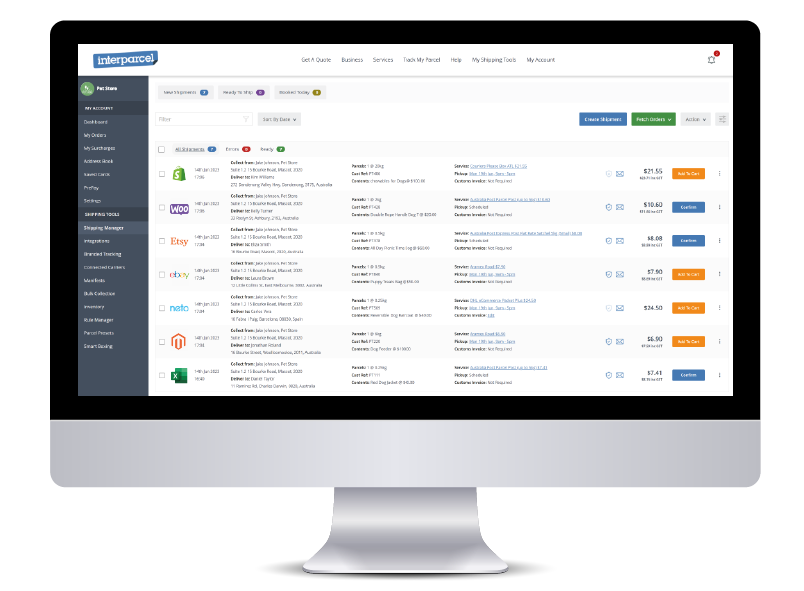If you're launching or scaling your ecommerce business, one of the first questions you'll face is where to sell your products.
Should you invest in building a dedicated online store from scratch?
Or start by listing your products on established marketplaces like eBay, Amazon, or Etsy?
There’s no one-size-fits-all answer. But for many small and medium-sized businesses, marketplaces offer a practical, low-barrier path to growth, especially when time, budget, or resources are limited.
This article explores how online marketplaces can support ecommerce growth, what to consider before listing, and how to simplify operations as your business expands.
Understanding the Role of Marketplaces in Ecommerce
Marketplaces are online platforms that allow third-party sellers to list and sell products to a wide audience.
Examples include Amazon, eBay, and Etsy. These platforms act as intermediaries, handling many of the technical, operational, and transactional tasks involved in ecommerce.

For businesses without the time or resources to build traffic to their own website, marketplaces offer an opportunity to get products in front of active, purchase-ready shoppers. They're designed to support sellers with tools that manage listings, process payments, and assist with fulfilment logistics.
Rather than replacing your own ecommerce store, marketplaces can complement it, allowing you to reach new customers, test product ideas, and grow revenue faster.
How Marketplaces Help You Scale Fast
Once you're set up and listing products, marketplaces can do more than just generate one-off sales, they can support real, sustainable growth.
Because they remove many of the traditional barriers associated with ecommerce, marketplaces allow businesses to focus less on infrastructure and more on strategy, product, and service.
Below are some of the key ways marketplaces can help ecommerce businesses, particularly small and medium-sized ones, to grow more quickly and efficiently.
1. Lower Barrier to Entry
Setting up a storefront on a marketplace typically requires minimal technical knowledge. In most cases, you can create an account, upload product listings, and begin selling within a day.
This makes marketplaces particularly valuable for:
- Testing new product ideas
- Launching a brand with limited capital
- Creating a secondary sales channel alongside your website
You don’t need to hire developers, design a website, or set up complex systems, as the infrastructure is already there.
2. Access to Built-In Traffic and Shopper Trust
Marketplaces attract millions of shoppers every month.
For example, Amazon brings in around 4.8 billion monthly visits worldwide, many of whom are ready to buy.
When you sell through a marketplace, you tap into an existing customer base, one that already trusts the platform and is familiar with how it works. This helps reduce friction in the buying process, potentially leading to higher conversion rates than a standalone website might achieve in its early stages.
3. Simplified Day-to-Day Operations
Marketplaces simplify many of the technical and operational aspects of selling online, such as:
- Payment processing: They act as the payment gateway and collect funds on your behalf, reducing the need for you to manage payment fraud or set up merchant accounts.
- Basic customer communications: Marketplaces typically provide a messaging system for customer queries, returns, and disputes. However, you’re still responsible for responding to customers within platform-set timeframes.
- Order confirmations and sales tracking: These platforms automatically send order confirmation emails and maintain transaction histories that help with bookkeeping.
This can reduce the administrative burden, especially for businesses with limited internal resources. Many platforms also offer centralised dashboards for managing your listings, sales, and account activity in one place.
4. Opportunities for Growth and Repeat Sales
Once you've built up a track record of delivering on time and receiving positive customer reviews, most marketplaces begin rewarding your listings with more visibility, and with that comes growth.
Many platforms offer features that allow sellers to amplify their reach or encourage repeat purchases, even though you don’t control the full shopping experience.
Here’s how that works:
- Sponsored listings and advertising: You can pay to boost your visibility in search results or category pages. These ads often appear at the top of search listings, giving your products an edge, especially in competitive categories.
- Storefront customisation (where available): Marketplaces like Etsy and eBay let you build a branded storefront where customers can view all your listings in one place. While it's not as flexible as your own website, it helps create a consistent experience and gives shoppers more reasons to explore your product range.
- Cross-selling and upselling tools: Some platforms automatically suggest related products from your store to customers based on what they're viewing or have purchased. This can increase basket size and overall revenue per customer.
- Follow and reorder features: On certain platforms, customers can follow your store or quickly reorder items. While you don’t always own the customer data, these features give you a path to repeat business.
Just keep in mind that these growth tools are tied to performance metrics. Fast shipping, good customer reviews, and low return rates help ensure your products continue to rank well and become eligible for these enhancements.

Important Considerations When Selling on Marketplaces
While marketplaces offer many benefits, they also come with some trade-offs.
- Fees: Most platforms charge listing fees, referral fees, or commissions on each sale.
- Branding limitations: You typically can't customise the shopping experience to reflect your full brand identity.
- Limited customer data: Customer relationships are managed through the platform, which may restrict your ability to remarket or personalise communications.
However, these limitations can be managed, especially if you're using marketplaces as part of a broader ecommerce strategy. Many businesses start on marketplaces, validate their product offering, and later invest in building their own store once they have a better understanding of their audience.
Streamlining Marketplace Operations with Shipping Tools
Managing orders from multiple marketplaces can become time-intensive as volume increases. That’s where an effective ecommerce shipping strategy can provide significant value. One important shipping technology to incorporate is a multicarrier shipping solutions.

By connecting your marketplace accounts to a multicarrier shipping tool, you can:
- Automatically import orders from different platforms into one dashboard
- Compare shipping rates from multiple couriers
- Print labels and book deliveries in bulk
- Provide customers with consistent tracking updates
This helps reduce time spent on fulfilment, avoid manual entry errors, and maintain a smoother post-purchase experience, even across multiple sales channels.
Start Growing with Marketplaces Today
Online marketplaces offer a flexible, low-risk way for ecommerce businesses to expand their reach and test new products without significant upfront investment. They’re especially useful for small and medium-sized sellers looking to gain traction, grow revenue, or complement their existing store.
While they may not offer complete control over branding or customer relationships, they provide valuable exposure, simplified operations, and access to large audiences that can accelerate growth.
If you're exploring ways to scale your ecommerce presence, marketplaces remain one of the most accessible and effective options available, especially when paired with tools that simplify order management and fulfilment across channels.










 Facebook
Facebook Twitter
Twitter Instagram
Instagram Linked In
Linked In YouTube
YouTube